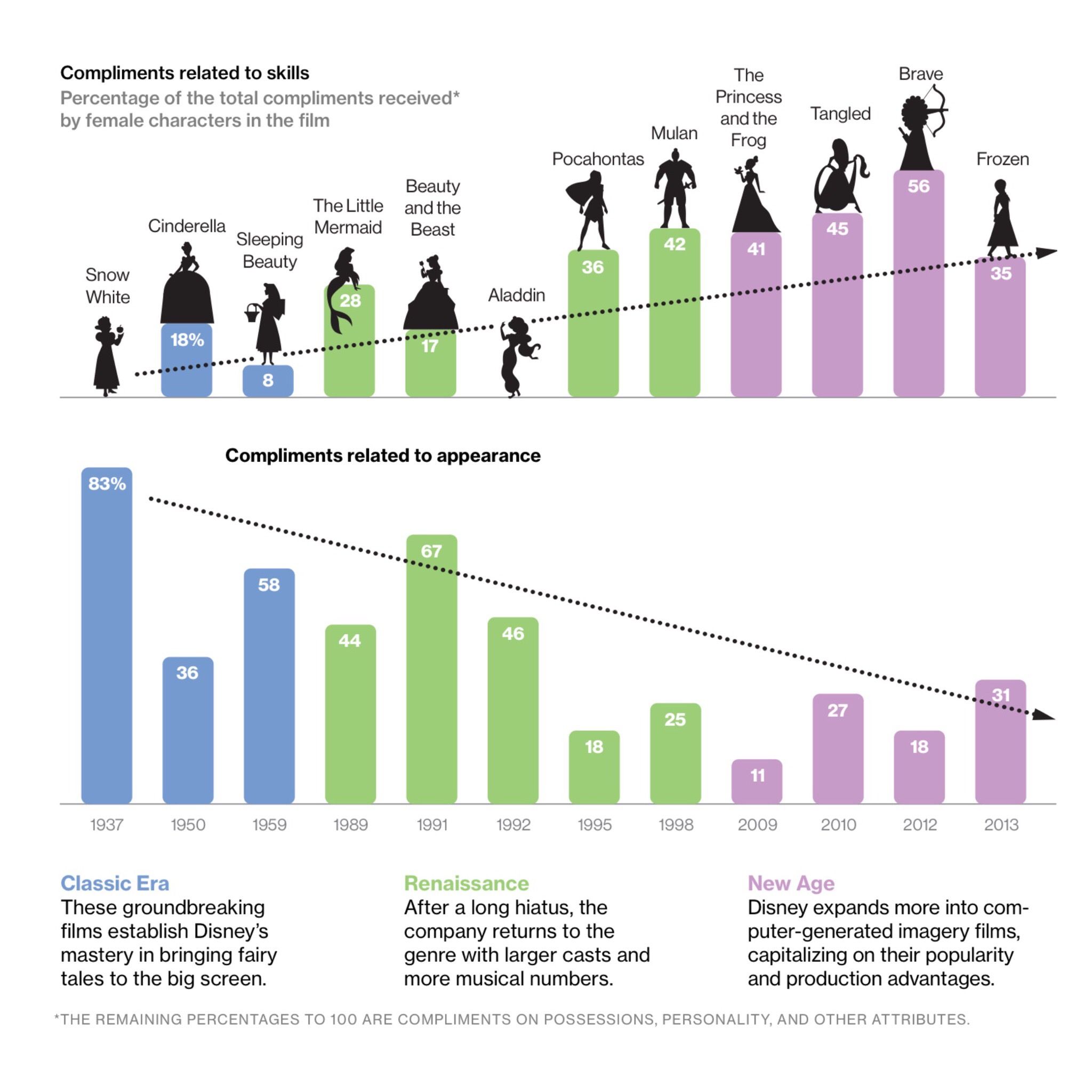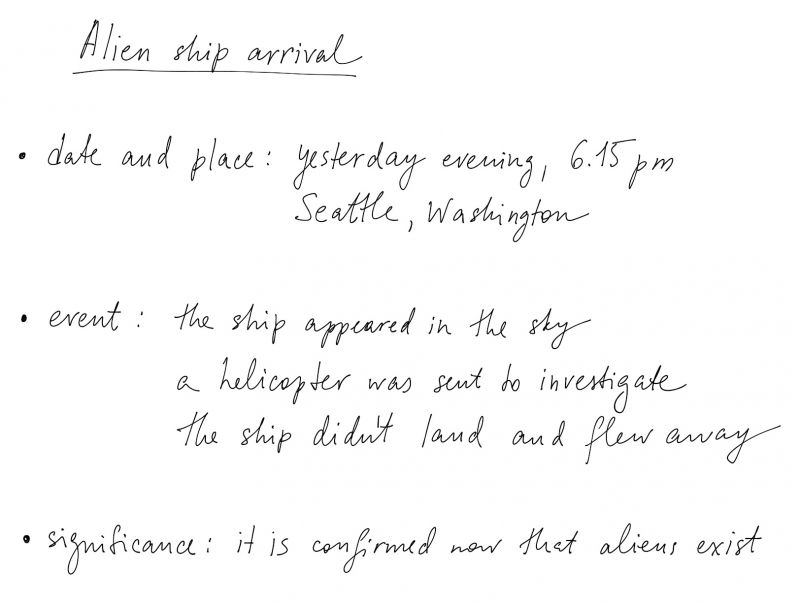Общая структура доклада
Доклад состоит из трёх частей: вступление, основная часть и заключение. Основная часть делится, в свою очередь, еще на несколько частей (как правило, 2–3). При этом и сам доклад, и все его части должны иметь заголовки. Также можно включить дату, расположив её под заголовком доклада. Например:
Subject: Changing Compliment Patterns in Disney Movies
Date: 18th January 2017
Purpose
(под этим заголовком располагается вступление)
Changes (вместо слова ‘changes’ нужно подставить свой заголовок)
(под этим заголовком располагается первая половина основной части)
Reasons (вместо слова ‘reasons’ нужно подставить свой заголовок)
(под этим заголовком располагается вторая половина основной части)
Conclusion
(под этим заголовком располагается заключение)
Примечания: вместо слова ‘purpose’ можно писать ‘introduction’. Вместо слова ‘conclusion’ можно писать ‘recommendation’, если вы пишете доклад-рекомендацию. На олимпиадах писать дату обычно не требуется. Можно переходить ко вступлению сразу после строки, на которой написана тема. Также не обязательно писать в теме слово Subject. Можно просто написать саму тему.
Вступление
Главная задача вступления в докладе — дать читателю понять, о чём будет доклад и с какой целью он написан. Если вы собираетесь описывать какие-нибудь меняющиеся показатели и объяснять причины изменений, то так и говорите во вступлении: «Цель доклада — обозначить изменения и объяснить их причины». Говорить нужно максимально по делу, без абстрактных рассуждений.
Разберем пример. Вам дали табличку, в которой представлены результаты некоего опроса о местном ресторане, и нужно написать по ней доклад. Неправильное вступление в формате report будет звучать так:
- Eating out is a very popular way of spending free time. Many people in our district often visit a local restaurant — the Ivy, which provides them with both food and pleasant atmosphere.
Это вступление является неподходящим, потому что мы уходим в абстрактные рассуждения (они годятся для эссе) и описания (они годятся для статей). Подходящее для формата report вступление будет звучать так:
- The aim of this report is to analyse the results of a survey in which 250 residents were questioned about the local Ivy restaurant. Basing on this analysis, the report provides recommendations on how to improve the service at the restaurant.
В этом вступлении мы сразу переходим к делу и явным образом указываем, о чем будет доклад.
Основная часть
В основной части вы выполняете изложенные в задании требования. Если нужно сравнить данные двух таблиц — сравниваете, если нужно объяснить причины изменений — объясняете, если нужно проанализировать диаграммы — анализируете. При этом необходимо не просто перечислять факты один за другим, а структурировать, группировать информацию. Структурирование и группирование делает информацию проще для восприятия и благотворно влияет на баллы как за содержательную, так и за организационную часть.
Информация без группирования и анализа (просто перечислили цифры из табличек с заданием, потеряли баллы за организацию и содержание):
- In 2000 60% of schoolchildren traveled for tourist purposes, 25% did that to attend summer language courses, and only 15% had higher education among their travelling goals. In 2014 about 28% became interested in higher education, 38% wanted to attend summer language courses and only 34% travelled for pleasure.
Группированная информация с анализом (не просто перечислили цифры, а подумали, как связаны между собой 2000 и 2014 год, что и обобщили в тексте):
- While in 2000 the principal reason for going abroad was tourism (at 60%), its role plummeted to only 34% in 2014. In contrast, educational purposes significance rose by approximately 10%, reaching 28% for higher education and 38% for summer language courses.
Заключение
Задача заключения — подвести итоги, суммировать всю изложенную информацию. В зависимости от того, какой у вас доклад, может также потребоваться выразить своё мнение или дать рекомендацию. Не пишите одно и то же шаблонное заключение к разным докладам — оно во многих случаях просто не выполнит своей функции. Как и в случае со вступлением, нужно писать по делу, не уходя в отвлеченные рассуждения.
Такое заключение не подойдет по формату (потому что содержит не относящиеся к делу общие рассуждения):
- To sum it all up, restaurants are an integral part of our life and the Ivy restaurant is not an exception. Although not everyone is satisfied with it, it still remains an attractive way to spend an evening with a friend.
А такое подойдет (потому что в нем все по делу):
- All points considered, some improvements evidently need to be made if clients are to be fully satisfied with the service provided by the restaurant.
Стиль
Доклад пишется в формальном стиле. Следует заменять простые структуры более сложными, использовать продвинутую лексику, страдательный залог, подходящие средства логической связи. Не должно быть разговорных выражений и сокращений.
- The service there is so cool! The waiters are very polite.
- The majority of those surveyed find the service at the restaurant excellent and note the politeness of the waiters.
Пример работы в формате report
Напишем ответ на такое задание:
Imagine that you are a linguist doing research into the dialogues in children’s animated films. You have collected some data on the ways female characters are complimented (see the charts below). Write a brief report describing the changes you have noticed comparing Disney movies over the years.
Write 220–250 words.
Use the following plan:
- make an opening statement;
- give some general information outlining the trend, analyze the information given in the charts;
- suggest possible reasons for the changes happening;
- make a conclusion.
Первое, что необходимо сделать — внимательно рассмотреть графики. Как только мы это сделаем, так сразу поймём, что есть две четко прослеживающиеся тенденции: комплиментов о внешности становится всё меньше, комплиментов о навыках и умениях — всё больше.
Уловив общее направление, найдем заметные, отличающиеся от остальных точки. Например, Snow White — ни одного комплимента, касающегося умений, зато 83% — о внешности. Pocahontas — первый женский персонаж в истории Диснея, у которого комплиментов о внешности меньше, чем комплиментов о талантах. Brave — максимальное количество комплиментов об умениях и навыках за всю историю. В общем, отмечаем для себя всё то, что сразу бросается в глаза. Причём отмечаем не в голове, а на бумаге:
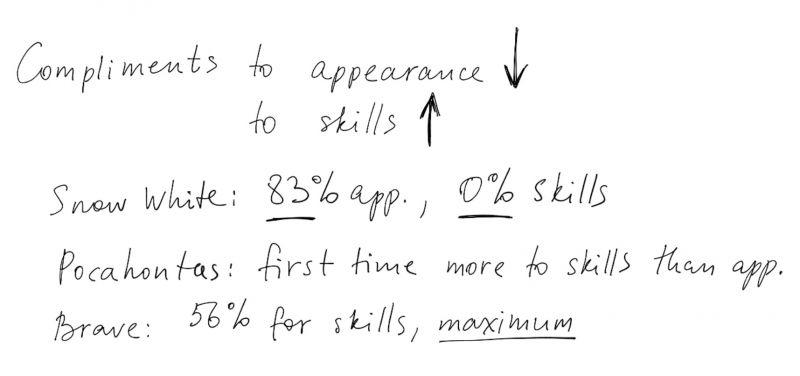
Дальше мы видим, что временная шкала разделена на три периода: Classic Era, Renaissance, New Age. Эти периоды помогут в структурировании информации о комплиментах, так что берем их на заметку.
Проведя таким образом первичный анализ графиков, мы переходим к составлению плана (подробно о составлении плана можно почитать в статье «Как составить план?»). Для составления плана нам нужно понять, как группировать информацию. Разумеется, в отдельные абзацы выйдут вступление и заключение. Также отдельным абзацем будут причины изменений. Что касается описания самих изменений, тут единственно верного варианта нет, организовывать можно по-разному. Например, разбить описание на два абзаца: skills compliments, appearance compliments. Можно разбить на три, в соответствии с периодами: Classic Era, Renaissance, New Age. Можно вообще не разбивать.
Выбирая способ группировки, нужно помнить о лимите на количество слов. В данном задании мы ограничены 250 словами. Из них около 80 уйдёт на вступление с заключением. Останется примерно 170 слов на основную часть. Если мы выберем вариант описания по периодам, то абзацев в основной части будет четыре: три для периодов и один для описания причин изменений. То есть, в одном абзаце получится всего лишь около 40 слов. Писать такие короткие, но при этом логически безупречные и информативные абзацы весьма непросто. Поэтому целесообразнее будет не дробить на мелкие кусочки, а остановиться на более крупных частях.
Я выберу вариант разделения основной части всего на два абзаца: изменения и их причины. Плюс такого способа я вижу в том, что расположение всех изменений в одном абзаце даст мне возможность активно сравнивать их между собой.
Отражаем все наши мысли в базовом плане:
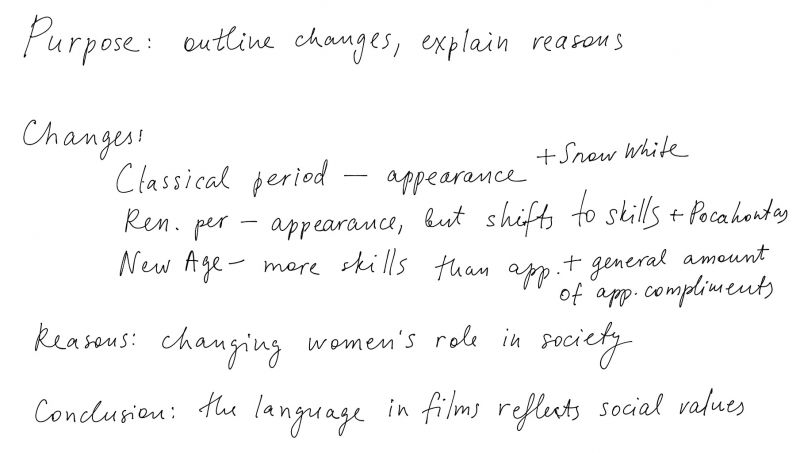
Когда базовый план готов, можно писать черновик, если на это хватает времени. Если времени мало, лучше детализировать план и, используя этот план, писать работу сразу начисто.
Напишем вступление. Во вступлении нужно обозначить цели и содержание доклада. Также нужно обозначить, откуда взялись данные, которые мы будем описывать.
The linguistic analysis of the dialogues from 12 Disney movies appearing over the period 1937–2013 has revealed certain alterations in the nature of the compliments paid to female characters. This report aims at outlining the discovered changes and explaining the reasons behind them.
Теперь напишем об изменениях. Для этого будем действовать по схеме обобщения и детализации. Как написано у нас в плане, в классических мультфильмах большинство комплиментов относится ко внешности. Примером служит Sleeping Beauty. Так и пишем:
In classic Disney animated films female characters receive several times the amount of praise for their appearance as for their skills and abilities. For instance, Snow White and Sleeping Beauty have respectively 83% and 58% compliments related to the way they look.
Проделываем аналогичную операцию со следующим периодом. Сначала обобщенно говорим о тенденции, потом даём пример:
The same trend generally remains during the renaissance Disney period, although it must be noted that it is then that a character appears (namely Pocahontas, 1995), who is given credit for her skills rather than attractiveness.
С последним периодом поступаем точно так же.
In most recent films the role of beauty-related compliments is noticeably lower — 20% on average, while showing respect for competence has risen in frequency, making up almost half of the total compliments in every film since 2009.
Обратите внимание, что хотя общая схема одинакова, при описании мы используем разные языковые структуры: several times the amount, respectively, the same trend remains, noticeably lower, on average, has risen in frequency. Чем они разнообразнее, тем выше будет оценена работа.
Также необходимо всеми силами избегать повторов. Например, чтобы не писать всё время ‘compliments on appearance’, мы используем синонимы: praise for their appearance, compliments related to the way they look, given credit, attractiveness, beauty-related compliments.
Следующий пункт — описание причин изменений. Это принципиально другой по своей сути текст. В отличие от предыдущего абзаца, он не просто передаёт объективные факты, взятые из графиков, а отражает личное мнение автора. Однако несмотря на это, он должен быть максимально обезличен в соответствии с особенностями формата report.
Differing compliment patterns might have been caused by the changing perception of women’s role in society. When a woman was primarily regarded as wife and mother, her value was mostly based on appearance. A shift towards engagement in activities other than household and motherhood was, in its turn, naturally followed by the increase in ability-related compliments.
Пассивные конструкции ‘might have been caused’, ‘was naturally followed’ позволяют добиться этого обезличивания.
Осталось написать заключение. Подведем итоги всему вышесказанному, кратко обозначив, что изменилось и почему.
To conclude, the quality of the compliments given to female characters in Disney movies has significantly altered, reflecting the ways the societal values have transformed over the past 76 years.
Наш report готов. Не забываем писать заголовки к каждому абзацу, а также к самому докладу.
Subject: Changing Compliments Patterns in Disney Movies
Purpose
The linguistic analysis of the dialogues from 12 Disney movies appearing over the period 1937–2013 has revealed certain alterations in the nature of the compliments paid to female characters. This report aims at outlining the discovered changes and explaining the reasons behind them.
Changes
In classic Disney animated films female characters receive several times the amount of praise for their appearance as for their skills and abilities. For instance, Snow White and Sleeping Beauty have respectively 83% and 58% compliments related to the way they look. The same trend generally remains during the renaissance Disney period, although it must be noted that it is then that a character appears (namely Pocahontas, 1995), who is given credit for her skills rather than attractiveness. In most recent films the role of beauty-related compliments is noticeably lower — 20% on average, while showing respect for competence has risen in frequency, making up almost half of the total compliments in every film since 2009.
Reasons
Differing compliment patterns might have been caused by the changing perception of women’s role in society. When a woman was primarily regarded as wife and mother, her value was mostly based on appearance. A shift towards engagement in activities other than household and motherhood was, in its turn, naturally followed by the increase in ability-related compliments.
Conclusion
To conclude, the quality of the compliments given to female characters in Disney movies has significantly altered, reflecting the ways the societal values have transformed over the past 76 years.
Подводные камни
Очень распространённая ошибка при написании доклада — несоответствие стиля. Использование личных местоимений (I think, I consider), сокращений (it’s, hasn’t), слишком простых предложений и разговорной лексики пагубно отражается на качестве доклада и на количестве получаемых за него баллов.
Useful language for a report
1. Stating the purpose of the report
-
The principal aim/objective/purpose of this report is to provide a description of… / to provide/to present results of /to assess the importance of …
-
In this report I will provide a description of … / I will provide/present results of …/ I will assess the importance of…
-
This report describes/provides an assessment of… / describes/provides/presents results of…
2. Describing how you got the information
-
I conducted a survey of / I conducted interviews with local council officers …
-
… responded to an online questionnaire.
-
I visited three of the most popular …
-
… were invited to attend a focus group…
3. Reporting your results
-
Most of those responding to the survey stated that/expressed the opinion that …
-
According to …
-
A large/considerable/significant/ proportion of respondents/informants/those surveyed said that …
-
Nearly three quarters of the …
4. Presenting a list
-
The arguments against … are the following:
-
…
-
…
-
The following were the main reasons given for supporting …: firstly, …, secondly, …
-
Points our informants mentioned in favour of/against … were:
-
…
-
…
-
There are several ways in which … might be … :
-
…
-
…
_________________________________________________________________________
- Details
- Last Updated: Friday, 03 September 2021 21:11
- Written by IELTS Mentor
- Hits: 1780056
Academic IELTS Writing Task 1 question requires you to use several vocabularies to present the data given in a pie/ bar/ line/ mixed graph or to describe a process or a flow chart. Being able to use appropriate vocabularies, presenting the main trend, comparing & contrasting data and presenting the logical flow of the graph ensure a high band score in your Academic IELTS writing task 1. This vocabulary section aims to help you learn all the vocabularies, phrases and words you need to know and use in your Academic writing task 1 to achieve a higher band score. The examiner will use four criteria to score your response: task achievement, coherence and cohesion, lexical resource, & grammatical range and accuracy. Since «Lexical Resource» will determine 25% of your score in Task 1, you have to enrich your vocabulary to hit a high band score. To demonstrate that you have a great lexical resource, you need to:
» Use correct synonyms in your writing.
» Use a range of vocabulary.
» Do not repeat words and phrases from the exam question unless there is no alternative.
» Use some less common vocabulary.
» Do not use the same word more than once/twice.
» Use precise and accurate words in a sentence.
It is advisable that you learn synonyms and use them accurately in your writing in order to give the impression that you can use a good range of vocabulary.
Graph Writing Vocabulary Index:
Part 1 | Part 2 | Part 3 | Part 4 | Part 5 |
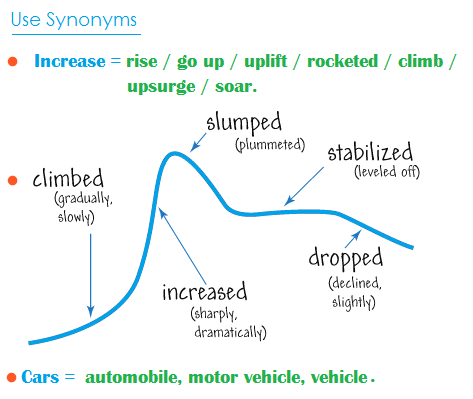
The general format for writing academic writing task 1 is as follows:
Introduction + Basic/ General Trends + Details Description + Summary (optional).
Each part has a specific format and therefore being equipped with the necessary vocabulary will help you answer task 1 efficiently and will save a great deal of time.
 Vocabulary for the Introduction Part:
Vocabulary for the Introduction Part:
|
Starting |
Presentation Type |
Verb |
Description |
|
The/ the given / the supplied / the presented / the shown / the provided |
diagram / table / figure / illustration / graph / chart / flow chart / picture/ presentation/ pie chart / bar graph/ column graph / line graph / table data/ data / information / pictorial/ process diagram/ map/ pie chart and table/ bar graph and pie chart … |
shows / represents / depicts / enumerates / illustrates / presents/ gives / provides / delineates/ outlines/ describes / delineates/ expresses/ denotes/ compares/ shows contrast / indicates / figures / gives data on / gives information on/ presents information about/ shows data about/ demonstrates/ sketch out/ summarises… |
the comparison of… |
Example :
1. The diagram shows employment rates among adults in four European countries from 1925 to 1985.
2. The given pie charts represent the proportion of male and female employees in 6 broad categories, dividing into manual and non-manual occupations in Australia, between 2010 and 2015.
3. The chart gives information about consumer expenditures on six products in four countries namely Germany, Italy, Britain and France.
4. The supplied bar graph compares the number of male and female graduates in three developing countries while the table data presents the overall literacy rate in these countries.
5. The bar graph and the table data depict the water consumption in different sectors in five regions.
6. The bar graph enumerates the money spent on different research projects while the column graph demonstrates the fund sources over a decade, commencing from 1981.
7. The line graph delineates the proportion of male and female employees in three different sectors in Australia between 2010 and 2015.
Note that, some teachers prefer the «The line graph demonstrates…» instead of «The given line graph demonstrates…». However, if you write «The given/ provided/ presented….» it would be correct as well.
Tips:
1. For a single graph use ‘s’ after the verb, like — gives data on, shows/ presents etc. However, if there are multiple graphs, DO NOT use ‘s’ after the verb.
2. If there are multiple graphs and each one presents a different type of data, you can write which graph presents what type of data and use ‘while’ to show a connection. For example — ‘The given bar graph shows the amount spent on fast food items in 2009 in the UK while the pie chart presents a comparison of people’s ages who spent more on fast food.
3. Your introduction should be quite impressive as it makes the first impression on the examiner. It either makes or breaks your overall score.
4. For multiple graphs and/ or table(s), you can write what they present in combination instead of saying which each graph depicts. For example, «The two pie charts and the column graph in combination depicts a picture of the crime in Australia from 2005 to 2015 and the percentages of young offenders during this period.»
Caution:
Never copy word for word from the question. If you do, you would be penalised. always paraphrase the introduction in your own words.
General Statement Part:
The General statement is the first sentence (or two) you write in your reporting. It should always deal with:
What + Where + When.
Example: The diagram presents information on the percentages of teachers who have expressed their views about the different problems they face when dealing with children in three Australian schools from 2001 to 2005.
What = the percentages of teachers…
Where = three Australian schools…
When = from 2001 to 2005…
A good General statement should always have these parts.
Vocabulary for the General Trend Part:
1. In general…
2. In common…
3. Generally speaking…
4. Overall…
5. It is obvious…
6. As it is observed…
7. As a general trend…
8. As can be seen…
9. As an overall trend/ As overall trend…
10. As it is presented…
11. It can be clearly seen that…
12. At the first glance…
13. It is clear,
14. At the onset…
15. It is clear that…
16. A glance at the graph(s) reveals that…
Example:
1. In general, the employment opportunities increased till 1970 and then declined throughout the next decade.
2. As it is observed, the figures for imprisonment in the five mentioned countries show no overall pattern, rather shows the considerable fluctuations from country to country.
3. Generally speaking, citizens in the USA had a far better life standard than that of the remaining countries.
4. As can be seen, the highest number of passengers used the London Underground station at 8:00 in the morning and at 6:00 in the evening.
4. Generally speaking, more men were engaged in managerial positions in 1987 than that of women in New York this year.
5. As an overall trend, the number of crimes reported increased fairly rapidly until the mid-seventies, remained constant for five years and finally, dropped to 20 cases a week after 1982.
6. At a first glance, it is clear that more percentages of native university pupils violated regulations and rules than the foreign students did during this period.
7. At the onset, it is clear that drinking in public and drink-driving were the most common reasons for US citizens to be arrested in 2014.
8. Overall, the leisure hours enjoyed by males, regardless of their employment status, was much higher than that of women.
The structure of the IELTS Academic Writing Task 1 (Report Writing):
Introduction:
Introduction (never copy word for word from the question) + Overview/ General trend (what the diagrams indicate at a first glance).
Reporting Details:
Main features in the Details
+ Comparison and Contrast of the data. (Do not give all the figures.)
+ Most striking features of the graph.
Conclusion:
Conclusion (General statement + Implications, significant comments)
[The conclusion part is optional.]
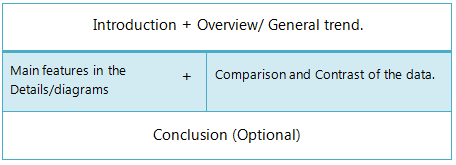
Tips:
1. Write the introduction and General trend in the same paragraph. Some students prefer to write the ‘General Trend’ in a separate paragraph and many teachers suggest both to be written in a single paragraph. Unless you have a really good reason to write the general trend in the second paragraph, try to write them both in the first paragraph. However, this is just a suggestion, not a requirement.
2. Your ‘Introduction (general statement + overall trend/ general trend) should have 75 — 80 words.
3. DO NOT give numbers, percentages or quantity in your general trend. Rather give the most striking feature of the graph that could be easily understood at a glance. Thus it is suggested to AVOID —
«A glance at the graphs reveals that 70% of the male were employed in 2001 while 40 thousand women in this year had jobs.»
And use a format /comparison like the following:
«A glance at the graphs reveals that more men were employed than their female counterparts in 2001 and almost two-third of females were jobless in the same year. «
Vocabulary to Start the Report Body:
Just after you finish writing your ‘Introduction’ (i.e. General Statement + General overview/ trend), you are expected to start a new paragraph to describe the main features of the diagrams. This second paragraph is called the ‘Body Paragraph / Report Body». You can have a single body paragraph/ report body or up to 3, (not more than 3 in any case) depending on the number of graphs provided in the question and the type of these graphs. There are certain phrases you can use to start your body paragraph and the following is a list of such phrases —
1. As it is presented in the diagram(s)/ graph(s)/ pie chart(s)/ table…
2. As (it is) shown in the illustration…
3. As can be seen in the…
4. As the diagrams suggest…
5. According to the…
6. Categorically speaking…
7. Getting back to the details…
8. Now, turning to the details…
9. The table data clearly shows that…
10. The diagram reveals that…
11. The data suggest that…
12. The graph gives the figure…
13. It is interesting to note that…
14. It is apparently seen that…
15. It is conspicuous that…
16. It is explicitly observed that…
17. It is obvious…
18. It is clear from the data…
19. It is worth noticing that…
20. It is crystal clear/ lucid that…
21. It can be clearly observed that…
22. It could be plainly viewed that…
23. It could be noticed that…
24. We can see that…
Vocabulary to show the changes:
|
Trends |
Verb form |
Noun Form |
|
Increase |
rise / increase / go up / uplift / rocket(ed) / climb / upsurge / soar/ shot up/ improve/ jump/ leap/ move upward/ skyrocket/ soar/ surge. |
a rise / an increase / an upward trend / a growth / a leap / a jump / an improvement/ a climb. |
|
Decrease |
fall / decrease / decline / plummet / plunge / drop / reduce / collapse / deterioriate/ dip / dive / go down / take a nosedive / slum / slide / go into free-fall. |
a fall / a decrease / a reduction / a downward trends /a downward tendency / a decline/ a drop / a slide / a collapse / a downfall. |
|
Steadiness |
unchanged / level out / remain constant / remain steady / plateau / remain the same / remain stable / remain static |
a steadiness/ a plateau / a stability/ a static |
|
Gradual increase |
———— |
an upward trend / an upward tendency / a ceiling trend |
|
Gradual decrease |
———— |
a downward trend / a downward tendency / a descending trend |
|
Standability/ Flat |
level(ed) off / remain(ed) constant / remain(ed) unchanged / remain(ed) stable / prevail(ed) consistency / plateaued / reach(ed) a plateau / stay(ed) uniform /immutable / level(ed) out/ stabilise/ remain(ed) the same. |
No change, a flat, a plateau. |
Examples:
1. The overall sale of the company increased by 20% at the end of the year.
2. The expenditure of the office remained constant for the last 6 months but the profit rose by almost 25%.
3. There was a 15% drop in the ratio of student enrollment at this University.
4. The population of the country remained almost the same as it was 2 years ago.
5. The population of these two cities increase significantly in the last two decades and it is expected that it will remain stable during the next 5 years.
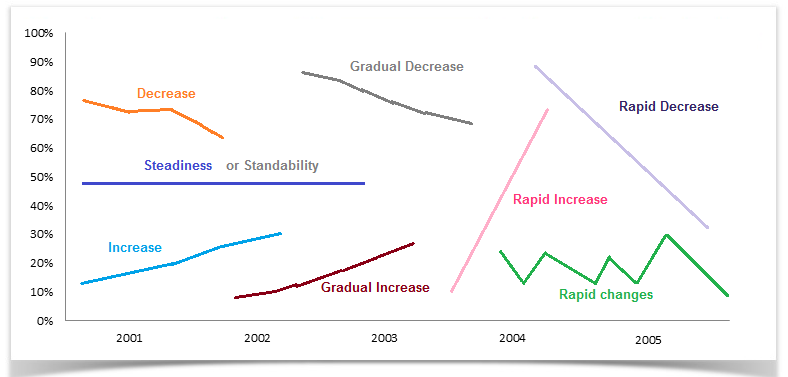
Tips:
1. Use ‘improve’ / ‘an improvement’ to describe a situation like economic condition or employment status. To denote numbers use other verbs/nouns like increase.
2. Do not use the same word/ phrase over and over again. In fact, you should not use a noun or verb form to describe a trend/change more than twice; once is better!
3. To achieve a high band score you need to use a variety of vocabulary as well as sentence formations.
Vocabulary to represent changes in graphs:
|
Type of Change |
Adverb form |
Adjective form |
|
Rapid change |
dramatically / rapidly / sharply / quickly / hurriedly / speedily / swiftly / significantly/ considerably / substantioally / noticably. |
dramatic / rapid / sharp / quick / hurried / speedy / swift / significant / considerable / substantial / noticable. |
|
Moderate change |
moderately / gradually / progressively / sequentially. |
moderate / gradual / progressive / sequential. |
|
Steady change |
steadily/ ceaselessly. |
steady/ ceaseless. |
|
Slight change |
slightly / slowly / mildly / tediously. |
slight / slow / mild / tedious. |
Example:
1. The economic inflation of the country increased sharply by 20% in 2008.
2. There was a sharp drop in industrial production in the year 2009.
3. The demand for new houses dramatically increased in 2002.
4. The population of the country dramatically increased in the last decade.
5. The price of oil moderately increased during the last quarter but as a consequence, the price of daily necessities rapidly went up.

|
Type of Change |
Verb form |
Noun form |
|
Rapid ups and downs |
wave / fluctuate / oscillate / vacillate / palpitate |
waves / fluctuations / oscillations / vacillations / palpitations |
Example:
1. The price of the goods fluctuated during the first three months of 2017.
2. The graph shows the oscillations of the price from 1998 to 2002.
3. The passenger number in this station oscillates throughout the day and in the early morning and evening, it remains busy.
4. The changes in car production in Japan shows a palpitation for the second quarter of the year.
5. The number of students in debate clubs fluctuated in different months of the year and rapid ups and downs could be observed in the last three months of this year.
Tips:
1. 4. DO NOT try to present every single piece of data presented in a graph. Rather pick 5-7 most significant and important trends/ changes and show their comparisons and contrasts.
2. The question asks you to write a report and summarise the data presented in graphs(s). This is why you need to show the comparisons, contrasts, show the highest and lowest points and the most striking features in your answer, not every piece of data presented in the diagram(s).
Types of Changes/ Differences and Vocabulary to present them:
Great change / Huge difference:
Adjectives Adverbs
Overwhelming Overwhelmingly
Substantial Substantially
Enormous Enormously
Big change / Big difference:
Adjectives Adverbs
Significant Significantly
Considerable Considerably
Medium change / Moderate difference:
Adjectives Adverbs
Somewhat Somewhat
Moderate Moderately
Minor change / Small difference:
Adjectives Adverbs
Fractional Fractionally
Marginal Marginally
Slight Slightly
Dates, Months & Years related vocabulary and grammar:
» From 1990 to 2000, Commencing from 1980, Between 1995 and 2005, After 2012.
» By 1995, In 1998, In February, Over the period, During the period, During 2011.
» In the first half of the year, For the first quarter, The last quarter of the year, During the first decade.
» In the 80s, In the 1980s, During the next 6 months, In the mid-70s, Next 10 years, Previous year, Next year, Between 1980 — 1990.
» Within a time span of ten years, within five years.
» Next month, Next quarter, Next year, Previous month, Previous year.
» Since, Then, From.
Percentage, Portion and Numbers:
Percentages:
10% increase, 25 percent decrease, increased by 15%, dropped by 10 per cent, fall at 50%, reached to 75%, tripled, doubled, one-fourth, three-quarters, half, double fold, treble, 5 times higher, 3 timers lower, declined to about 49%, stood exactly at 43%.
Fractions:
4% = A tiny fraction.
24% = Almost a quarter.
25% Exactly a quarter.
26% = Roughly one quarter.
32% Nearly one-third, nearly a third.
49% = Around a half, just under a half.
50% Exactly a half.
51% = Just over a half.
73% = Nearly three quarters.
77% = Approximately three quarter, more than three-quarter.
79% = Well over three quarters.
Proportions:
2% = A tiny portion, a very small proportion.
4% = An insignificant minority, an insignificant proportion.
16% = A small minority, a small portion.
70% = A large proportion.
72% = A significant majority, A significant proportion.89% = A very large proportion.
89% = A very large proportion.
Words/ Phrases of Approximation — Vocabulary:
» Approximately
» Nearly
» Roughly
» Almost
» About
» Around
» More or less
» Just over
» Just under
» Just around
» Just about
» Just below
» A little more than
» A little less than.
What criteria would a band 9 graph response satisfy?
Task Achievement:
A) Fully satisfies all the requirements of the task.
B) Clearly presents a fully developed response.
What will be assessed by the examiner?
a) How appropriately, accurately and relevantly you fulfil your task requirements.
b) How accurately you write your report and how appropriately you present the data (compare/ contrast/ show the most striking trends/ features/ data.)
Coherence and Cohesion:
A) Uses cohesion in such a way that it attracts no attention.
B) Skillfully manages «paragraphing».
What will be assessed by the examiner?
a) No misinterpretation and presentation of data and trends.
b) How well you organise your paragraphs.
c) Overall clarity and fluency of your report and message.
d) How well you have organised and liked the information, data and ideas in your writing.
e) Logical sequencing and appropriate use of linking devices between and within your sentences.
Tips:
1. Do not incorporate more than 3-4 paragraphs.
2. Do not use a single paragraph to describe everything.
3. The conclusion part is optional. If you think that you have already written more than 170 words and have nothing to say, you can skip the conclusion.
Lexical Resource:
A) Uses a wide range of vocabulary with very natural and sophisticated control of lexical features.
B) Rare minor errors occur only as «slips».
a) The range of vocabulary you have used in your writing.
b) How accurately and appropriately you have used words/ phrases while presenting the graph(s) as a report.
Tips: Do NOT use words/ phrases that are already given in the question. Do so only if there is no alternative word(s)/ phrase(s) to convey the same meaning/idea.

Grammatical Range and Accuracy:
A) Uses a wide range of structures with full flexibility and accuracy.
B) Rare minor errors occur only as «slips».
Tips:
Do not use the same sentence structure and data comparison/ contrasting style over and over again. Bring a variety in your writing to show that you can formulate different sentence structures without making any grammatical mistakes.
Next »» Graph Writing Vocabulary (Part 2)»

clicking here.
This message will disappear when then podcast has fully loaded.
On this page you will find some language for
reports.
The language provides further examples of the
formulaic language
used in academic contexts. As with other formulaic language (e.g. the
language for presentations), you do not need to learn all of
these phrases. You should be able to use at least one phrase for each function
(e.g. stating the
aim(s) of your report,
referring to figures in the
Results section or the
Discussion section).
How many more you learn after this is up to you.
Good writing requires varying the expressions you use,
rather than using the same ones all the time. On the other hand, you will
only state the aim once in a report, so one phrase may be enough for life!
Preliminaries
For another look at the same content, check out the video on YouTube (also available on
Youku).
The title of your report will depend very much on the subject matter, and will be very individual. Nonetheless, there
are some useful verbs and phrases which can be used in titles, especially for science reports. These include:
- Investigating X
- Calculating X
- Measuring X
- Demonstrating X
- Analysing X
- Determining X
- An Investigation into X
- A Demonstration of X
- An Analysis of X
There is no special language for writing abstracts or contents pages, which are the other components of the prilimaries of a report.
Introduction
Background
You may need to talk about something in general in the background section of your introduction.
The most common way is to use [No article] + [plural]. For example:
- Mobile phones have become very popular in China in recent years.
It is also possible to use [The] + [singular]. For example:
- The mobile phone has become very popular in China in recent years.
The background section of your introduction is likely to require
in-text citations. Some structures for citations are given below. For more, see the
references and citations section.
| According to X (2000, p.115) … | ||
| As X (2000, p.115) | states/points out/suggests | , … |
| X (2000, p.115) | that… | |
| X (2000, p.115) | defines Y as … | |
| … | (X, 2000, p.115). |
Theory
You may need to
give definitions and
classify in this section.
See the relevant pages on the website for language for definitions and classification.
If you want to refer to theories or principles, you can use the following structures.
| As stated by | Newton’s First Law, … |
| According to | |
| Newton’s First law | states that… |
The following structures can be used for presenting equations.
| The equation for Z is… | (where X is … and Y is …) |
| The equation of Z can be written… | |
| The Z equation can be given as … | |
| The following equation of Z can be obtained: … |
The following phrases can be used for stating what something stands for or represents.
- X stands for/represents/denotes/symbolizes Y
- Y is represented by X
- Y is denoted by X
- Y is symbolized by X
- …where X is/stands for/denotes/represents Y
Aims
This part of the report explains why you are writing the report.
The tense you use will depend on whether the subject of the sentence is
the report (which still exists) or the
experiment (which has finished).
If you are referring to the report, you should use present tense.
If you are referring to the experiment, which has finished, you should use past tense.
| The aim/purpose/objective of this report is firstly to |
research [sth] discover [wh-] investigate/find out [sth or wh-] measure [sth] |
| A second/third/final aim (of the report) is to | |
| The aim/purpose/objective of the experiment was to | |
| The experiment aimed to |
Examples of aims, using the above structures, are given below.
- The aim of this experiment was to measure the value of gravity in Guangzhou by using a simple pendulum.
- The aim of this report is to investigate whether class size has a significant effect on student achievement.
Method
The Method section outlines how you gathered information. Because academic language does not usually use ‘I’ or ‘we’, this
section will often contain passive structures, usually the past passive (because the experiment or survey is finished). It
can be useful to use transition signals to show sequence or process, such as the ones below.
- First(ly)/Initially/At first/At the beginning/To begin with…
- Second(ly)/Then/Next/Subsequently/After that…
- Finally/At the end/Lastly…
- After doing X, Y was done.
- After X was done, Y was done.
- Before/prior to doing X, Y was done.
- Before X was done, Y was done.
- Prior to X being done, Y was done.
For example:
- After measuring the length of the string, the bob was moved several degrees.
Science reports will usually include apparatus for conducting the experiment.
The following phrases can be used for describing the apparatus.
| The apparatus | used in the experiment | consisted of… |
| comprised… | ||
| was set up as shown in the diagram below. |
Results
If you use tables, charts, etc., the following language can be used to refer to these.
Note that this language is description, i.e. it does not analyse or draw conclusions.
| Figure X |
gives shows indicates |
Y/information about Y |
| Table X |
Discussion
The following language can be used for referring to graphs etc. in the Discussion section. Unlike similar phrases used for the
Findings section, which merely describe, this language discusses,
i.e. it says what the information means.
| As can be seen from |
the chart, the figure, the table, the graph, Table 1, Figure 2, |
… |
| According to | ||
| As is shown in | ||
| It can be seen from | that… |
The following phrases can be used for science reports when comparing the results to those expected.
| This result can be compared with | the given/accepted value of X, which is… |
| This result/value agrees with | |
| This result/value is close to | |
| The calculated answer is a little different to |
The following phrases can be used when discussing how errors may have affected the results.
| Errors | may have arisen | in the measurement of X, thereby affecting the results. |
| A further error | from neglect of X, which might have affected the results. |
Conclusion
There is not much language for conclusions, though
conclusion signals such as ‘In conclusion’ are useful.
For science reports, the following phrases can be used to indicate the degree of accuracy.
| The results obtained | agree with | the given/accepted/true value of X. |
| partly agree with | ||
| are close to | ||
| are a little different from |
Recommendations
Recommendations can use the following modal verb constructions
| X should | [verb] |
| it is recommended that X |
Examples, using the above structures, are given below.
- Based on the conclusions above, it is recommended that the company consider paying more attention to above-the-line promotion in order to attract new customers.
- Further research should be carried out to find out if these opinions are true in other market segments.
If you are writing a lab report, the following conditional structures can be used to indicate how the experiment could have been improved.
| If | X had been [done] (instead of Y) | the results might have been more accurate. |
| The results might have been more accurate if | . |
References
There is no language for reference sections, but you can refer to the section on
reference sections for more information on these.
Appendices
There is no language for appendices, though the following may be used in the main body to refer to the appendices.
- A complete copy of X is shown in Appendix 1.
- For more detail, refer to Appendix 1, which shows…
- See Appendix 1 for more information.

GET FREE EBOOK
Like the website? Try the books. Enter your email to receive a free sample from Academic Writing Genres.

Checklist
There is a downloadable
checklist for reports
(structure and language) in the
writing resources section.
Report writing. Как написать доклад на английском языке
С помощью доклада мы описываем, анализируем, критикуем исследование или просто какие-то данные. Умение грамотно оформить информацию в таком формате очень ценно по двум причинам:
В этой статье речь пойдет о том, чем доклад отличается от эссе (essay), а также из каких частей он состоит.
Peculiarities of report. Особенности доклада на английском
Report structure. Структура доклада на английском языке
Секрет успешного написания хорошего доклада – работа по плану. Report имеет свою стандартную структуру, которую нужно взять за основу. Итак, в любом докладе должно быть 5 элементов:
В полноценном докладе также должен быть список использованной литературы. Могут присутствовать и другие части, это зависит от предмета и цели доклада. Соответственно, если мы имеем дело с кратким докладом, например, на международном экзамене, необходимо продемонстрировать не столько знание выбранной темы, сколько в целом понимание того, что такое доклад и из каких частей он состоит. Так, описанные выше части доклада на экзамене немного упрощаются, и выглядят так:
Чтобы еще лучше понимать, как писать доклад на английском, можете посмотреть это короткое, но познавательное видео:
Доклад на английском языке отличается от других видов письменных работ. Возьмите на вооружение те основы и советы, которые вы нашли в этой статье, и у вас обязательно получится написать хороший доклад! А также не забудьте скачать список слов, которые пригодятся вам при написании доклада.
Если вы нашли ошибку, пожалуйста, выделите фрагмент текста и нажмите Ctrl+Enter.
Источник
Review, report, proposal и letter в CAE Writing
Review, report, proposal и letter в CAE Writing
Если эссе — обязательный вариант первой части CAE Writing, то во второй можно сделать выбор из трех. В идеале нужно знать требования к четырем заявленным в CAE текстам: report, proposal, review и letter. Но достаточно выбрать два-три и работать над ними вместо гонки за всеми зайцами.
Все критерии Cambridge официально поместил в шкалу оценивания и показал, как анализируют работы письменные экзаменаторы.
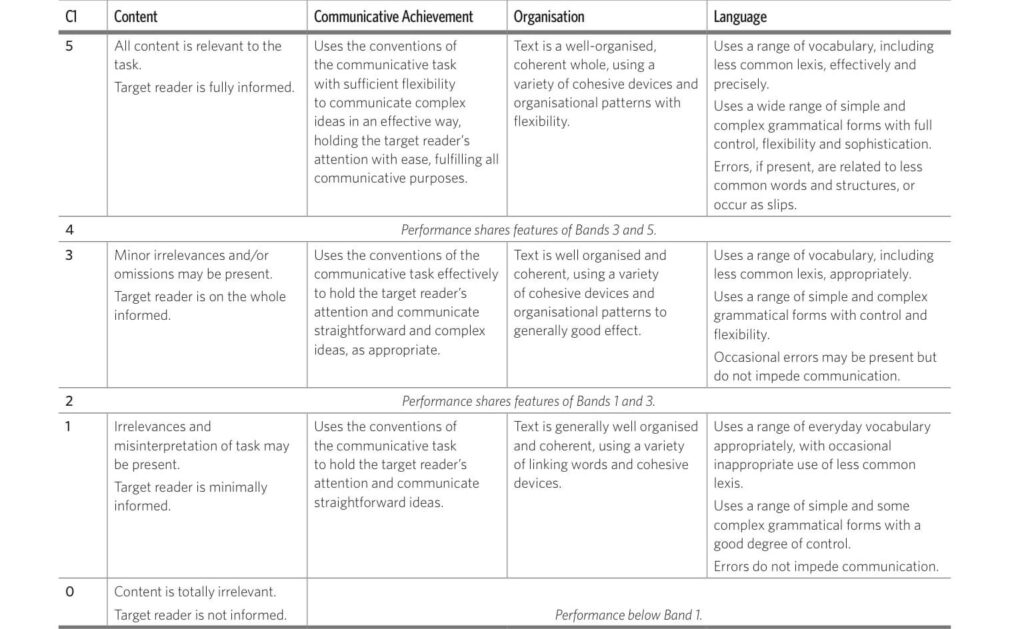
Самостоятельно пробираться по этим терминам и описаниям — тот ещё квест. Такая таблица в чистом виде больше парализует, чем сдвинет с места. Поэтому своим студентам я выдаю базовые моменты, от которых мы отталкиваемся, чтобы написать самый первый текст:
Тaк называемые samples на 17-20 баллов создают прекрасный ориентир на высший Pass A именно за письмо, когда за эссе и вторую часть выходит 34-40 баллов. Но у меня был случай, когда мы со студенткой добирали баллы на Pass за счет Speaking и довольствовались средним результатом 12-14 баллов за каждый письменный текст. Вдруг у вас тоже такой случай. Поэтому я публикую здесь самые разные примеры.
Мне нравятся подробные задания в CAE Writing. Если к ним присмотреться, выделить ключевые слова в предложениях, то проблем с начальными идеями для текста быть не должно. Остается только их развить по правилам жанра, которые я здесь привожу вместе с образцами. К сожалению, я не могу по пунктам расписать языковые и логические требования к письменной работе на Pass, Pass B или Pass A. Предпочитаю делать подробные рекомендации, отталкиваясь от самого первого текста студента.
Пример на 16 баллов из 20. Ключевые слова выделены.
You have just finished a three-week study and work programme in an English-speaking country. You have studied English in the mornings and worked for a local company in the afternoons. The programme organizer has asked you to write a report about your experience. In your report, you should evaluate the programme, explaining which part of the program was more useful, and suggest changes you would recommend for next year’s programme.

Proposal
Пример ниже на 12 баллов. Адрес писать не нужно, как в примере. Так proposal становится похож на formal letter.
There are plans to demolish an old and unused building in the town where you are a student. You feel that the building should be saved. You decide to write a proposal for the town council explaining why you think the building should be preserved, suggesting what could be done to modernize it and saying how the building could benefit the local people.
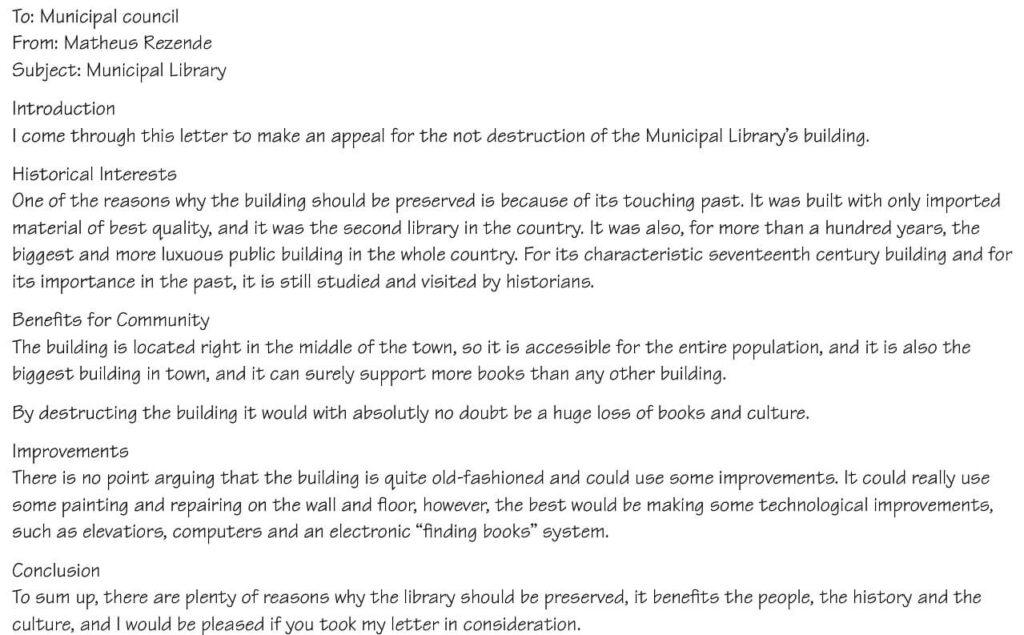
Review
Пример на 14 баллов.
You see the following announcement on a website, «Great Lives»:
Send us a review of a book or a film that focuses on somebody who has made an important contribution to society. Did you learn anything new about the person’s life the book or film? Did the book or film help you understand why this person made their important contribution?

Letter/ email
Письма бывают самые разные. В результате, приходится готовить много видов с разными целями, а не один, как в предыдущих заданиях. Книга «Successful Writing. Proficiency» by Virginia Evans дает исчерпывающие материалы. Вот основные виды писем в CAE, которые стоит из нее взять:
Здесь пример письма другу на 17 баллов. Задача — посоветовать.
My new job is great, and next month I get to travel on business. Guess what — I’m actually coming to your town for a week!
I’ll be free some evenings and one weekend. I want to make the most of this opportunity, so I’d like your advice please: where to go, what to do, and why?
Cheers,
Chris
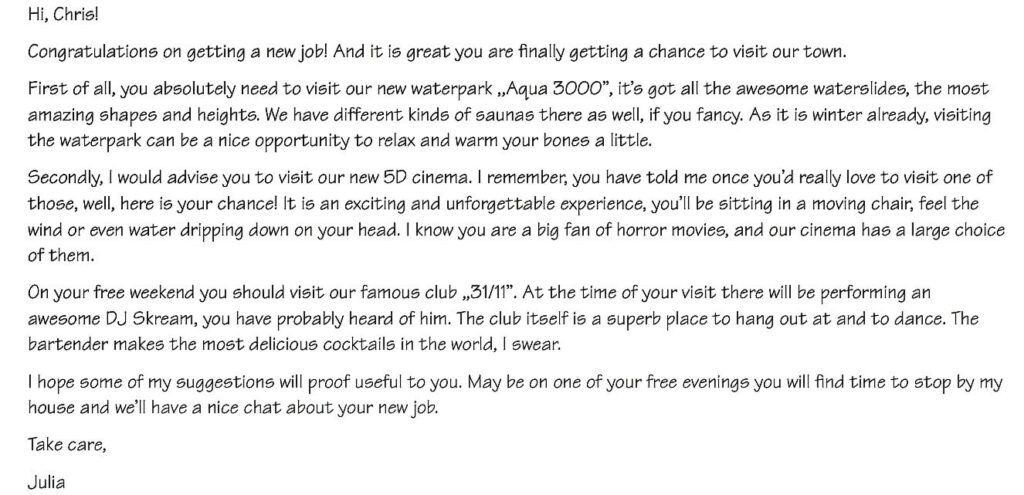
Фото — Cambridge English: Advanced. Handbook for Teachers и Pixabay.
Источник
Как писать News Report (новостная статья)?
Формат news report или news article сложно назвать популярным, однако он всё же встречается в некоторых олимпиадах. Например, «Покори Воробьёвы горы!» уже несколько лет даёт новостные статьи на отборочных турах во всех классах.
Цель любой новостной статьи — рассказать читателю о каком-либо событии, предоставить ему фактическую информацию. Дальнейшие детали отличаются в зависимости от конкретных требований, указанных в задании.
В данной статье мы рассмотрим свойства, которыми обладает любой news report.
Общая структура новостной статьи
Заголовок
Вступление
Основная часть
В основной части излагаются подробности кратко описанных во вступлении событий. Например, если во вступлении вы сообщили, что 1–го сентября в Хогвартсе прошла ежегодная церемония начала учебного года, то в основной части можно рассказать, как именно она прошла: о чём говорили, чем угощали и т.д.
Кроме того, в основной части может содержаться любая другая информация, относящаяся к событию: объяснение причин и результатов события, цитаты участников и очевидцев.
Заключение
В отличие от заключений большинства других форматов, в заключениях news reports не нужно дублировать информацию из вступления или подытоживать сказанное в основной части. Вместо этого следует оценить значимость события, рассказать о дальнейших планирующихся событиях или описать реакцию людей на событие.
Примечание. Вышеизложенные правила — общие, стандартные для формата новостной статьи. К заданиям на олимпиадах часто прилагается определённый план, который может не во всём совпадать с общими правилами. Разумеется, при выполнении задания нужно всегда опираться на тот план, который в нём предложен.
Стиль
Пример работы в формате news report
The newspaper you work for has asked you to cover the recent arrival of an alien ship. Write a news report in about 200–250 words.
Your news report should:
Make sure that all your descriptions match the picture below.
Сначала внимательно рассмотрим картинку, поскольку она в данном случае — единственный ограничитель нашей фантазии. На картинке мы видим большой город, космический корабль и вертолет. Следовательно, мы не можем написать, например, что событие произошло в селе Коньково, что оно прошло незамеченным, что инопланетяне появились из-под земли — это не будет соответствовать картинке. Зато остальные детали — на наше усмотрение. Мы можем сами решить, приземлился этот корабль или улетел, вышли из него инопланетяне или он оказался управляемым автоматически, дружественный был визит или враждебный.
Составим приблизительный план нашей новостной статьи, отталкиваясь от предложенного плана (подробно почитать о составлении плана можно в статье «Как составить план?»).
Нам нужно будет разбить статью минимум на три абзаца:
Пишем первый абзац, в котором излагаем всю основную информацию: что, где, когда, кто участвовал. Отвлечённых вступлений и заходов издалека следует избегать.
The question of the existence of aliens has interested scientists for centuries. Are we the only intelligent creatures in the Universe or are there others? Now all the doubts are finally resolved — a spaceship that arrived yesterday above Seattle has proved that extraterrestrials are real.
A large alien spaceship appeared in the sky above Seattle, Washington, yesterday evening. After remaining stationary for several hours, it flew away, leaving no traces behind. More than 300,000 people witnessed the event.
Mr Cruncher, one of the first witnesses, reported having seen the spacecraft at about 6:15 p.m.: «It was an unusual shadow that caught my attention. I looked up — and here it was, enormous and intimidating!». The object, a grayish-white disc, about 200 meters in diameter, hung still in the air for nearly 5 hours. It was monitored constantly by 9 helicopters, sent by the local government.
Обратите внимание, что необязательно повторять структуру вступления и снова писать ‘the spaceship arrived’. Вместо этого можно использовать прямую речь какого-нибудь свидетеля. Это оживит и разнообразит статью, а также сделает её более правдоподобной.
Рассказывая о корабле, не стоит вдаваться в детали слишком глубоко, ведь мы ограничены всего 200–250 словами. Но подробности упомянуть, тем не менее, необходимо. Конкретные факты предпочтительнее размытых описаний. Например, ‘200 meters in diameter’ — более подходящее для новостной статьи описание, чем ‘extraordinarily big’, ‘presumably, an alloy of steel and nickel’ — лучше, чем ‘we do not really know what it is made of’.
In spite of close surveillance, very little information was gathered, since the interior of the ship was impenetrable. Neither was it possible to take samples of the materials composing the vessel (presumably, they are an alloy of steel and nickel). The ship showed no signs of working engines, so it remains unclear what kind of power it used to travel throughout space. Another grey area is whether the spaceship was manned or controlled automatically.
To sum up, the spacecraft appeared in Seattle yesterday evening and was seen by the majority of the citizens. It spent about 5 hours above the city and disappeared afterwards. This is the first extraterrestrial visit to Earth.
The event received worldwide attention both in scientific communities and among ordinary people. This is the first time that the existence of aliens has been publicly witnessed and carefully documented. Scientists predict further visits which will throw new light on the event. «We finally know that we’re not alone in the Universe, and further contacts are bound to be established», commented Mr. Daniel Flumpengo, a paranormal research expert in Stanford University.
Заголовок
Статья полностью готова, займёмся заголовком. Придумывать его можно, конечно, в любой момент, но я предпочитаю делать это именно в конце, когда тело новости уже сложилось и точно не будет меняться. Заголовок должен отражать суть статьи и, в идеале, привлекать внимание. В нашем случае внимание привлекает сама тема, поэтому можно обойтись без дополнительных ухищрений.
Seattle receives extraterrestrial guests
Seattle receives extraterrestrial guests
A large alien spaceship appeared in the sky above Seattle, Washington, yesterday evening. After remaining stationary for several hours, it flew away, leaving no trace behind. More than 300,000 people witnessed the event.
Mr Cruncher, one of the first witnesses, reported having seen the spacecraft at about 6:15 p.m.: «It was an unusual shadow that caught my attention. I looked up — and there it was, enormous and intimidating!». The object, a grayish-white disc, about 200 meters in diameter, hung still in the air for nearly 5 hours. It was monitored constantly by 9 helicopters, sent by the local government.
In spite of close surveillance, very little information was gathered, since the interior of the ship was impenetrable. Neither was it possible to take samples of the materials composing the vessel (presumably, they are an alloy of steel and nickel). The ship showed no signs of working engines, therefore it remains unclear what kind of power it uses to travel throughout space. Another grey area is whether the spaceship was manned or controlled automatically.
The event received worldwide attention both in scientific communities and among ordinary people. This is the first time that the existence of aliens has been publicly witnessed and carefully documented. Scientists predict further visits which will throw new light on the event. «We finally know that we’re not alone in the Universe, and further contacts are bound to be established», commented Mr. Daniel Flumpengo, a paranormal research expert in Stanford University.
Подводные камни
Стараясь нарисовать яркий образ, некоторые авторы применяют стратегии, уместные в повествовании, но неуместные в новостной статье.
It was a cloudy September evening, when the people of Seattle suddenly noticed a large spaceship soaring high above them in the sky. It was huge, intimidating and overwhelming, and stayed there motionless for several hours. Then, when it must have completed what it had come for, the alien vessel flew away.
A large alien spaceship appeared in the sky above Seattle, Washington, yesterday evening. After remaining stationary for several hours, it took off and went away, leaving no traces behind.
Описания погоды и местности, не относящиеся к событию непосредственно (cloudy September evening), оценочные прилагательные (intimidating, overwhelming), рассуждения (when it must have completed what it had come for) — всё это подойдёт для формата short story, но не годится для новостной статьи.
Основное отличие review от news report в том, что в рецензии автор делится своим личным мнением, в то время как в новостной статье он излагает сухие факты, удерживая личные впечатления и эмоции при себе.
Today I went to the start-of-term banquet in Hogwarts. I can swear it is the best event I have ever visited.
Today, a traditional start-of-term banquet took place in Hogwarts Hall. The event was, as usual, impressive and magnificent.
Поскольку цель новостной статьи — сообщать что-нибудь новое, присутствующие в ней описания должны быть максимально динамичными и непосредственно связанными с излагаемыми событиями.
The Great Hall is the main gathering area in the Old Hogwarts Castle where young students have their meals and receive magic owl post. Also, special events are organised there.
The event took place in the Great Hall of Hogwarts — a traditional place used for holding the start-of-term feasts. Four tables were laid for the students, and one for the staff, with an eye-catching throne-like chair for the Headmaster.
Вступление должно содержать основную информацию о событии, а не общие рассуждения.
The start-of-term feast is a traditional event in Hogwarts School of Witchcraft and Wizardry. It is a really important night for every student of this School.
Yesterday, a banquet took place in Hogwarts School of Witchcraft and Wizardry, marking the beginning of a school year.
Даже если автор новостной статьи находится под сильным впечатлением от события, он должен излагать факты нейтрально и обезличенно.
The tables were covered with all types of meals you could ever imagine.
The food on the tables was plentiful and diverse.
Источник
Как писать report (доклад)?
Общие факты
Report (доклад) часто встречается на международных экзаменах, а также на некоторых олимпиадах. Особенно любят этот формат на Всероссийской олимпиаде: с 2012 по 2016 год он успел побывать на всех этапах, кроме школьного, и во всех классах, кроме 5–6. Олимпиада «Покори Воробьёвы горы!» регулярно выбирает report для своих финалов. Элементы этого формата присутствуют также на Ведомственной олимпиаде, да и не только на ней.
Суть любого доклада — предоставление читателю чётко организованной фактической информации. Дальнейшие детали отличаются в зависимости от типа доклада и конкретных требований, указанных в задании.
В данной статье мы рассмотрим свойства, которыми обладает любой report. Обратите внимание, что в каждой отдельно взятой олимпиаде помимо этих свойств могут потребоваться и другие, прописанные в самом задании.
Общая структура доклада
Доклад состоит из трёх частей: вступление, основная часть и заключение. Основная часть делится, в свою очередь, еще на несколько частей (как правило, 2–3). При этом и сам доклад, и все его части должны иметь заголовки. Также можно включить дату, расположив её под заголовком доклада. Например:
Subject: Changing Compliment Patterns in Disney Movies
Date: 18th January 2017
Purpose
(под этим заголовком располагается вступление)
Changes (вместо слова ‘changes’ нужно подставить свой заголовок)
(под этим заголовком располагается первая половина основной части)
Reasons (вместо слова ‘reasons’ нужно подставить свой заголовок)
(под этим заголовком располагается вторая половина основной части)
Conclusion
(под этим заголовком располагается заключение)
Примечания: вместо слова ‘purpose’ можно писать ‘introduction’. Вместо слова ‘conclusion’ можно писать ‘recommendation’, если вы пишете доклад-рекомендацию. На олимпиадах писать дату обычно не требуется. Можно переходить ко вступлению сразу после строки, на которой написана тема. Также не обязательно писать в теме слово Subject. Можно просто написать саму тему.
Вступление
Главная задача вступления в докладе — дать читателю понять, о чём будет доклад и с какой целью он написан. Если вы собираетесь описывать какие-нибудь меняющиеся показатели и объяснять причины изменений, то так и говорите во вступлении: «Цель доклада — обозначить изменения и объяснить их причины». Говорить нужно максимально по делу, без абстрактных рассуждений.
Разберем пример. Вам дали табличку, в которой представлены результаты некоего опроса о местном ресторане, и нужно написать по ней доклад. Неправильное вступление в формате report будет звучать так:
Это вступление является неподходящим, потому что мы уходим в абстрактные рассуждения (они годятся для эссе) и описания (они годятся для статей). Подходящее для формата report вступление будет звучать так:
В этом вступлении мы сразу переходим к делу и явным образом указываем, о чем будет доклад.
Основная часть
В основной части вы выполняете изложенные в задании требования. Если нужно сравнить данные двух таблиц — сравниваете, если нужно объяснить причины изменений — объясняете, если нужно проанализировать диаграммы — анализируете. При этом необходимо не просто перечислять факты один за другим, а структурировать, группировать информацию. Структурирование и группирование делает информацию проще для восприятия и благотворно влияет на баллы как за содержательную, так и за организационную часть.
Информация без группирования и анализа (просто перечислили цифры из табличек с заданием, потеряли баллы за организацию и содержание):
Группированная информация с анализом (не просто перечислили цифры, а подумали, как связаны между собой 2000 и 2014 год, что и обобщили в тексте):
Заключение
Задача заключения — подвести итоги, суммировать всю изложенную информацию. В зависимости от того, какой у вас доклад, может также потребоваться выразить своё мнение или дать рекомендацию. Не пишите одно и то же шаблонное заключение к разным докладам — оно во многих случаях просто не выполнит своей функции. Как и в случае со вступлением, нужно писать по делу, не уходя в отвлеченные рассуждения.
Такое заключение не подойдет по формату (потому что содержит не относящиеся к делу общие рассуждения):
А такое подойдет (потому что в нем все по делу):
Стиль
Доклад пишется в формальном стиле. Следует заменять простые структуры более сложными, использовать продвинутую лексику, страдательный залог, подходящие средства логической связи. Не должно быть разговорных выражений и сокращений.
Пример работы в формате report
Imagine that you are a linguist doing research into the dialogues in children’s animated films. You have collected some data on the ways female characters are complimented (see the charts below). Write a brief report describing the changes you have noticed comparing Disney movies over the years.
Write 220–250 words.
Use the following plan:
Первое, что необходимо сделать — внимательно рассмотреть графики. Как только мы это сделаем, так сразу поймём, что есть две четко прослеживающиеся тенденции: комплиментов о внешности становится всё меньше, комплиментов о навыках и умениях — всё больше.
Уловив общее направление, найдем заметные, отличающиеся от остальных точки. Например, Snow White — ни одного комплимента, касающегося умений, зато 83% — о внешности. Pocahontas — первый женский персонаж в истории Диснея, у которого комплиментов о внешности меньше, чем комплиментов о талантах. Brave — максимальное количество комплиментов об умениях и навыках за всю историю. В общем, отмечаем для себя всё то, что сразу бросается в глаза. Причём отмечаем не в голове, а на бумаге:
Дальше мы видим, что временная шкала разделена на три периода: Classic Era, Renaissance, New Age. Эти периоды помогут в структурировании информации о комплиментах, так что берем их на заметку.
Проведя таким образом первичный анализ графиков, мы переходим к составлению плана (подробно о составлении плана можно почитать в статье «Как составить план?»). Для составления плана нам нужно понять, как группировать информацию. Разумеется, в отдельные абзацы выйдут вступление и заключение. Также отдельным абзацем будут причины изменений. Что касается описания самих изменений, тут единственно верного варианта нет, организовывать можно по-разному. Например, разбить описание на два абзаца: skills compliments, appearance compliments. Можно разбить на три, в соответствии с периодами: Classic Era, Renaissance, New Age. Можно вообще не разбивать.
Выбирая способ группировки, нужно помнить о лимите на количество слов. В данном задании мы ограничены 250 словами. Из них около 80 уйдёт на вступление с заключением. Останется примерно 170 слов на основную часть. Если мы выберем вариант описания по периодам, то абзацев в основной части будет четыре: три для периодов и один для описания причин изменений. То есть, в одном абзаце получится всего лишь около 40 слов. Писать такие короткие, но при этом логически безупречные и информативные абзацы весьма непросто. Поэтому целесообразнее будет не дробить на мелкие кусочки, а остановиться на более крупных частях.
Я выберу вариант разделения основной части всего на два абзаца: изменения и их причины. Плюс такого способа я вижу в том, что расположение всех изменений в одном абзаце даст мне возможность активно сравнивать их между собой.
Отражаем все наши мысли в базовом плане:
Когда базовый план готов, можно писать черновик, если на это хватает времени. Если времени мало, лучше детализировать план и, используя этот план, писать работу сразу начисто.
Напишем вступление. Во вступлении нужно обозначить цели и содержание доклада. Также нужно обозначить, откуда взялись данные, которые мы будем описывать.
The linguistic analysis of the dialogues from 12 Disney movies appearing over the period 1937–2013 has revealed certain alterations in the nature of the compliments paid to female characters. This report aims at outlining the discovered changes and explaining the reasons behind them.
Теперь напишем об изменениях. Для этого будем действовать по схеме обобщения и детализации. Как написано у нас в плане, в классических мультфильмах большинство комплиментов относится ко внешности. Примером служит Sleeping Beauty. Так и пишем:
In classic Disney animated films female characters receive several times the amount of praise for their appearance as for their skills and abilities. For instance, Snow White and Sleeping Beauty have respectively 83% and 58% compliments related to the way they look.
Проделываем аналогичную операцию со следующим периодом. Сначала обобщенно говорим о тенденции, потом даём пример:
The same trend generally remains during the renaissance Disney period, although it must be noted that it is then that a character appears (namely Pocahontas, 1995), who is given credit for her skills rather than attractiveness.
С последним периодом поступаем точно так же.
In most recent films the role of beauty-related compliments is noticeably lower — 20% on average, while showing respect for competence has risen in frequency, making up almost half of the total compliments in every film since 2009.
Обратите внимание, что хотя общая схема одинакова, при описании мы используем разные языковые структуры: several times the amount, respectively, the same trend remains, noticeably lower, on average, has risen in frequency. Чем они разнообразнее, тем выше будет оценена работа.
Также необходимо всеми силами избегать повторов. Например, чтобы не писать всё время ‘compliments on appearance’, мы используем синонимы: praise for their appearance, compliments related to the way they look, given credit, attractiveness, beauty-related compliments.
Следующий пункт — описание причин изменений. Это принципиально другой по своей сути текст. В отличие от предыдущего абзаца, он не просто передаёт объективные факты, взятые из графиков, а отражает личное мнение автора. Однако несмотря на это, он должен быть максимально обезличен в соответствии с особенностями формата report.
Differing compliment patterns might have been caused by the changing perception of women’s role in society. When a woman was primarily regarded as wife and mother, her value was mostly based on appearance. A shift towards engagement in activities other than household and motherhood was, in its turn, naturally followed by the increase in ability-related compliments.
Пассивные конструкции ‘might have been caused’, ‘was naturally followed’ позволяют добиться этого обезличивания.
Осталось написать заключение. Подведем итоги всему вышесказанному, кратко обозначив, что изменилось и почему.
To conclude, the quality of the compliments given to female characters in Disney movies has significantly altered, reflecting the ways the societal values have transformed over the past 76 years.
Наш report готов. Не забываем писать заголовки к каждому абзацу, а также к самому докладу.
Subject: Changing Compliments Patterns in Disney Movies
The linguistic analysis of the dialogues from 12 Disney movies appearing over the period 1937–2013 has revealed certain alterations in the nature of the compliments paid to female characters. This report aims at outlining the discovered changes and explaining the reasons behind them.
In classic Disney animated films female characters receive several times the amount of praise for their appearance as for their skills and abilities. For instance, Snow White and Sleeping Beauty have respectively 83% and 58% compliments related to the way they look. The same trend generally remains during the renaissance Disney period, although it must be noted that it is then that a character appears (namely Pocahontas, 1995), who is given credit for her skills rather than attractiveness. In most recent films the role of beauty-related compliments is noticeably lower — 20% on average, while showing respect for competence has risen in frequency, making up almost half of the total compliments in every film since 2009.
Differing compliment patterns might have been caused by the changing perception of women’s role in society. When a woman was primarily regarded as wife and mother, her value was mostly based on appearance. A shift towards engagement in activities other than household and motherhood was, in its turn, naturally followed by the increase in ability-related compliments.
To conclude, the quality of the compliments given to female characters in Disney movies has significantly altered, reflecting the ways the societal values have transformed over the past 76 years.
Подводные камни
I have collected the necessary data and made diagrams to represent the pattern of change.
The data collected during the research is used in the diagrams representing the pattern of change.
In this era characters on average received 40–45% of compliments to their skills. It’s more than ever.
The number of skill-related compliments rises to its historical maximum of 40–45% during this period.
It’s hard not to see a bad-ass like Mulan as an improvement over a movie like Sleeping Beauty, in which the titular character is literally passed out for a large portion of the film.
Such uncompromising and aggressive characters like Mulan are viewed as an improvement over passive ones, incapable of controlling their own fate, Snow White serving an example.
. Cinderella had 18% of compliments, Sleeping Beauty 8% whereas Snow White didn’t receive any compliments related to her skill. However, Snow White is the most complimented on her appearance character in the whole Disney’s history (83%).
. Nevertheless the character of «Aladdin» didn’t receive any compliments as Snow White. The most flattered princess of her appearance in that era is female from «Beauty and the Beast». She receives 67% of compliments.
Snow White, who received more compliments on her beauty than any other Disney female character (83%), did not get any praise for her skills, while Sleeping Beauty and Cinderella belonging to the same era have 8% and 18% ability-related compliments respectively.
Источник

